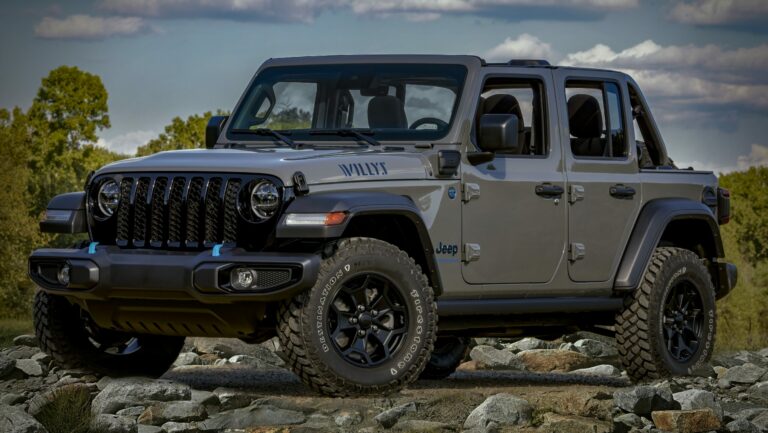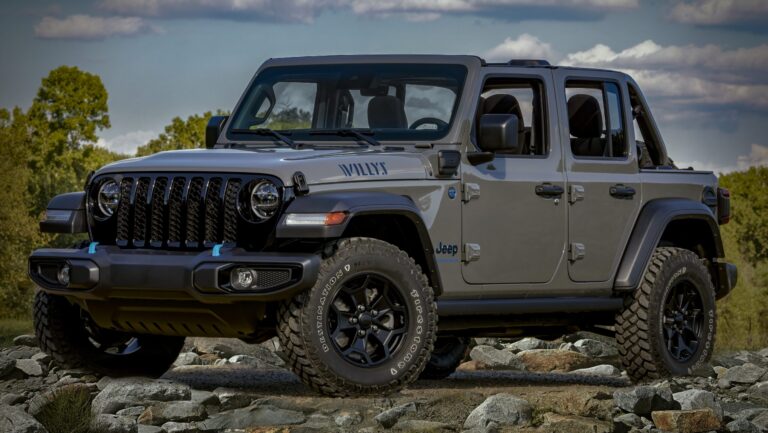1988 Jeep Comanche For Sale: A Comprehensive Buyer’s Guide
1988 Jeep Comanche For Sale: A Comprehensive Buyer’s Guide /jeeps.truckstrend.com
Introduction: The Enduring Allure of the 1988 Jeep Comanche
In the vast landscape of classic American trucks, the 1988 Jeep Comanche stands as a distinctive and increasingly sought-after icon. Born from the venerable XJ Cherokee platform, the Comanche (model code MJ) offered Jeep’s legendary off-road capability in a practical, unibody pickup truck format. For 1988, the Comanche was a mature offering, boasting the robust 4.0-liter "Renix" inline-six engine that would become synonymous with Jeep’s reliability and power.
1988 Jeep Comanche For Sale: A Comprehensive Buyer’s Guide
Today, finding a 1988 Jeep Comanche for sale isn’t just about acquiring a vintage vehicle; it’s about investing in a piece of automotive history that blends rugged utility with classic style. These trucks are celebrated for their simplicity, durability, and surprising comfort, making them ideal candidates for daily drivers, weekend adventurers, or even dedicated restoration projects. Whether you’re a seasoned Jeep enthusiast or a newcomer to the world of classic trucks, understanding the nuances of the 1988 Comanche is crucial before making a purchase. This comprehensive guide will arm you with the knowledge needed to navigate the market and find your perfect MJ.
The Enduring Appeal of the 1988 Jeep Comanche
The 1988 Jeep Comanche holds a special place in the hearts of many for several compelling reasons, contributing to its rising popularity in the used market:
- Unibody Design: Unlike traditional body-on-frame trucks, the Comanche’s unibody construction (shared with the XJ Cherokee) offered a lighter, more rigid chassis, leading to a surprisingly refined ride and handling for a truck of its era. This also contributed to its agility off-road.
- Legendary Powertrains:
- 4.0L Renix Inline-Six (I6): This engine, producing 177 horsepower and 224 lb-ft of torque in 1988, is the undisputed star. Known for its incredible longevity, torquey nature, and relative simplicity, it’s a major draw. While the "Renix" (Renault Bendix) fuel injection system can have its quirks, a well-maintained 4.0L is a powerhouse.
- 2.5L AMC Inline-Four (I4): Also available, this engine offered better fuel economy but significantly less power (117 hp, 135 lb-ft). While adequate for light duty, most buyers prefer the 4.0L.

- Transmission Options: Buyers could choose between a manual transmission (typically the Aisin AX-15 5-speed with the 4.0L, or the BA-10/5 Peugeot 5-speed with the 4.0L early in the year, or AX-4/AX-5 with the 2.5L) or an automatic (AW4 4-speed automatic with the 4.0L, or TF-904 3-speed automatic with the 2.5L). The AX-15 and AW4 are highly regarded for their durability.
- Drivetrain Versatility: Comanches were available in both 2WD and 4WD configurations. 4WD models often featured either the robust Command-Trac (part-time 4WD) or the more advanced Selec-Trac (full-time capable 4WD) transfer cases, enhancing their off-road prowess.
- Practicality and Utility: Available with either a 6-foot (short bed) or 7-foot (long bed) cargo box, the Comanche was a true utility vehicle. Its compact size made it maneuverable, while still offering ample hauling capacity for its class.
- Growing Collector Status: As XJ Cherokees become scarcer and more expensive, the rarer Comanche is gaining significant traction among collectors and enthusiasts who appreciate its unique blend of Jeep heritage and truck utility.
What to Look For When Buying a 1988 Jeep Comanche
Purchasing a 36-year-old vehicle requires a discerning eye. Here are the critical areas to inspect when considering a 1988 Jeep Comanche for sale:
1. Rust, Rust, and More Rust

This is the single most important factor. The unibody construction means rust can be a structural issue.
- Frame Rails: Inspect the "frame rails" (subframe components integrated into the unibody) from front to back, especially near the suspension mounting points and behind the front wheels.
- Floorboards & Rocker Panels: Check under the carpet and along the exterior rocker panels.
- Bed: Look for rust in the bed floor, wheel wells, and tailgate. The area where the bed meets the cab is also prone to rust.
- Cab Corners: These are notorious rust spots.
- Fenders & Doors: Inspect for bubbling paint, especially around wheel arches and lower door seams.
2. Engine Condition (Especially the 4.0L Renix)
- Oil Leaks: A minor rear main seal leak is common and often not a deal-breaker, but excessive leaks elsewhere (valve cover, oil pan) warrant concern.
- Cooling System: Check for signs of overheating (discolored coolant, warped head), leaky hoses, or a failing water pump. The cooling system is critical for the 4.0L’s longevity.
- Renix System Quirks: The Renix fuel injection system relies heavily on good grounds and healthy sensors (CPS, TPS, MAP). Rough idle, stalling, or poor performance can often be traced to these. Check wiring harnesses for brittle insulation or splices.
- Listen for Noises: Ticking (lifters), knocking (rod bearings), or unusual sounds.
3. Transmission & Drivetrain
- Manual Transmissions: Check clutch engagement, smooth shifting, and any grinding. The Peugeot BA-10/5 is known to be weaker than the later AX-15.
- Automatic Transmission (AW4): Ensure smooth shifts, no slipping, and proper engagement in all gears. Check fluid color and smell.
- Transfer Case: Engage 4WD (both high and low range) to ensure it shifts smoothly without grinding or binding. Check for leaks.
- Driveshafts & U-Joints: Look for play or clunking sounds.
- Differentials: Check for leaks and unusual noises.
4. Suspension & Steering
- Bushings: Worn control arm bushings, leaf spring bushings, and sway bar bushings are common.
- Ball Joints & Tie Rod Ends: Check for play.
- Steering Box: Excessive play in the steering wheel could indicate a worn steering box.
- "Death Wobble": While not exclusive to Comanches, the XJ platform can suffer from "death wobble" – a violent front-end shake. This is usually caused by a combination of worn steering/suspension components.
5. Brakes
- Pad & Rotor Wear: Standard checks.
- Brake Lines: Inspect for rust or corrosion, especially flexible lines.
- Drum Brakes (Rear): Check for leaks from wheel cylinders.
6. Electrical System & Interior
- Gauges & Lights: Ensure all dashboard gauges work correctly. Test all exterior lights.
- Power Accessories: If equipped, test power windows, door locks, and mirrors.
- Heater & AC: Check their functionality.
- Interior Condition: Assess seats, dashboard, headliner, and door panels for rips, cracks, or damage.
Common Issues and Solutions for the 1988 Comanche
- Renix Electrical Gremlins: Many issues with the 4.0L Renix engine can be resolved by cleaning and refreshing engine grounds, inspecting the Crankshaft Position Sensor (CPS) wiring, and ensuring good connections to the MAP, TPS, and O2 sensors.
- Cooling System Overhaul: Due to the age, a complete cooling system refresh (new radiator, water pump, thermostat, hoses, fan clutch) is often a wise preventative measure, especially on 4.0L models.
- Rear Main Seal Leak: This is almost a rite of passage for 4.0L owners. While it requires dropping the oil pan and potentially the transmission, it’s a common and manageable repair.
- Rust Repair: Depending on severity, rust repair can range from patching small areas to extensive bodywork. Factor this into your budget.
- Aftermarket Support: One of the greatest advantages of the Comanche is its shared DNA with the XJ Cherokee. This means a vast aftermarket parts supply for everything from engine components to suspension upgrades and interior bits.
- Modifications: Many Comanches have been lifted or modified. While this can enhance capability, ensure modifications were done correctly and don’t compromise safety or drivability.
Finding Your Ideal 1988 Jeep Comanche
- Online Marketplaces: Facebook Marketplace, Craigslist, eBay Motors, and dedicated classic car sites (e.g., Hemmings, Bring a Trailer for higher-end examples) are great starting points.
- Dedicated Forums: Websites like ComancheClub.com are invaluable resources. Members often sell their trucks, and you can gain insights from experienced owners.
- Local Searches: Check local classifieds, attend car shows, and spread the word among enthusiasts.
- Scrutinize Listings: Look for detailed descriptions, high-quality photos (including undercarriage shots), and maintenance records.
- Ask Questions: Don’t hesitate to ask about rust history, recent maintenance, specific issues, and why the owner is selling.
- Pre-Purchase Inspection (PPI): If you’re serious, especially with an out-of-state vehicle, arrange for a qualified mechanic specializing in older Jeeps or 4x4s to perform a PPI. This investment can save you thousands down the road.
Valuation and Pricing Considerations
The price of a 1988 Jeep Comanche can vary wildly based on condition, mileage, powertrain, and trim level.
- Condition is King: A rust-free, well-maintained, running-and-driving example will command a significantly higher price than a rusty project truck.
- Engine/Transmission Combo: 4.0L I6 models, especially with the AX-15 manual transmission, are generally more desirable and fetch higher prices.
- 4WD vs. 2WD: 4WD models are typically more sought after.
- Trim Levels: Higher trims like the "Eliminator" or "Pioneer" with more features or specific appearance packages might fetch a premium.
- Mileage: While lower mileage is generally preferred, a higher-mileage Comanche with excellent maintenance records can be a better buy than a low-mileage neglected one.
- Location: Vehicles from dry, salt-free climates (Southwest, West Coast) often command higher prices due to less rust.
1988 Jeep Comanche Estimated Price Guide
| Condition Category | Estimated Price Range (USD) | Key Factors Influencing Price |
|---|---|---|
| Project/Parts Car | $1,000 – $3,500 | Significant rust, major mechanical issues, non-running, incomplete. |
| Fair/Driver Quality | $3,500 – $7,500 | Visible rust, needs substantial mechanical attention, rough interior/exterior, but generally runs. |
| Good/Solid Driver | $7,500 – $14,000 | Minimal structural rust, runs well, minor cosmetic flaws, may need some maintenance updates. |
| Excellent/Restored | $14,000 – $25,000+ | Near rust-free, strong mechanicals, clean paint & interior, well-maintained or recently restored. |
| Concours/Show Quality | $25,000 – $40,000+ | Extremely rare, perfectly restored to original or better, low mileage, highly optioned. |
Note: Prices are estimates and can fluctuate based on market demand, specific options, modifications, and recent sales data.
Frequently Asked Questions (FAQ) About the 1988 Jeep Comanche
Q1: Is the 1988 Jeep Comanche reliable?
A1: Yes, especially models equipped with the 4.0L I6 engine and AW4 automatic or AX-15 manual transmission. These powertrains are known for their extreme durability. However, like any older vehicle, regular maintenance is key, and some age-related issues (like rust or sensor failures in the Renix system) should be expected and addressed.
Q2: What’s the difference between the 2.5L and 4.0L engine?
A2: The 4.0L inline-six is significantly more powerful (177 hp vs. 117 hp) and torquey, making it the preferred choice for most buyers, especially those looking for capability or daily driving. The 2.5L inline-four offers better fuel economy but feels underpowered by comparison.
Q3: Are parts hard to find for the 1988 Comanche?
A3: No, surprisingly. Because the Comanche shares most of its mechanical components and much of its interior with the highly popular XJ Cherokee (1984-2001), aftermarket support is excellent. Engine, transmission, suspension, and many interior parts are readily available. Body-specific parts (like the bed or rear bumper) can be harder to source rust-free, but they do exist.
Q4: Can I daily drive a 1988 Comanche?
A4: Absolutely, many people do. A well-maintained 4.0L Comanche with good cooling and rust mitigation can be a reliable and fun daily driver. Its relatively compact size and unibody ride quality make it more comfortable than many traditional pickups of its era.
Q5: What is the "Renix" system?
A5: "Renix" refers to the specific engine management system (fuel injection and ignition) used on the 4.0L Jeep engines from 1987 to 1990. It was a joint venture between Renault and Bendix. While robust, it can be sensitive to poor electrical grounds and failing sensors, which can sometimes make diagnosis tricky without specialized knowledge or tools.
Q6: What is "death wobble"?
A6: "Death wobble" is a phenomenon where the front axle experiences a violent, uncontrollable oscillation, often triggered by hitting a bump at speed. It’s a common issue across many solid-axle vehicles, including the Comanche. It’s almost always caused by a combination of worn front-end components (e.g., track bar, tie rods, ball joints, control arm bushings, steering damper). It’s repairable but requires thorough diagnosis.
Conclusion: The Rewarding Pursuit of a Classic Jeep Truck
The 1988 Jeep Comanche for sale represents more than just a vintage truck; it’s a testament to Jeep’s innovative spirit and engineering prowess. Its unique unibody design, coupled with the legendary 4.0L engine, offers a driving experience that blends rugged utility with surprising comfort and agility. As these trucks continue to age, their distinctive charm and increasing rarity only enhance their appeal.
While purchasing a 1988 Comanche requires careful inspection, particularly for rust and the health of its original components, the rewards are substantial. With a little patience and a keen eye, you can find a robust, characterful, and highly capable vehicle that stands out from the crowd. For the enthusiast or the practical classic car owner, the 1988 Jeep Comanche offers a truly unique and rewarding ownership experience, promising years of adventures on and off the beaten path.







